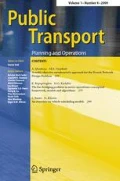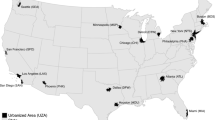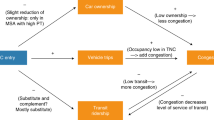Abstract
In this paper we measure the impact of public transportation on household vehicle ownership and use. Advanced econometric models are estimated on household travel survey data and on geographic data. In particular, data from the 2009 US National Household Travel Survey is merged with geographic information obtained from the General Transit Feed Specification source. The integration of variables specific to the spatial and temporal coverage of the transit service allows the analysis of different policy scenarios. Results obtained for the Washington DC Metropolitan Area indicate that enhanced transit services reduce the number of private vehicles and vehicle miles traveled. Effects are more marked when bus services are improved and on car use. The study is important for all Metropolitan Regions that are dealing with the problem of congestion, high levels of greenhouse gas emissions and that are planning to invest in more efficient and accessible public transportation services.


Similar content being viewed by others
References
Addison J (2010) Ten reasons for drop in car ownership. Clean Fleet Report. (See http://www.cleanfleetreport.com/clean-fleet-articles/car-ownership-declines/)
American Public Transportation Association (2013) Obama proposes investments for public transportation. (See http://newsmanager.commpartners.com/aptapt/issues/2013-02-22/index.html)
Arrington GB, Cervero R (2008) Effects of TOD on housing, parking, and travel. Transit Cooperative Research Program, Report 128.) (See http://onlinepubs.trb.org/onlinepubs/tcrp/tcrp_rpt_128.pdf.)
Arrington GB, Sloop KI (2010) New transit cooperative research program research confirms transit-oriented developments produce fewer auto trips. ITE J 79(6):26–29
Bhat CR, Guo J (2007) A comprehensive analysis of built environment characteristics on household residential choice and auto ownership levels. Transp Res Part B: Methodol 41(5):506–526
Bratzel S (1999) Conditions of success in sustainable urban transport policy— change in ‘relatively successful’ European cities. Transp Rev 19:177–190
Bunt P, Joyce P (1998) Car ownership patterns near rapid transit stations. Canadian Institute of Transportation Engineers. (See http://www.citebc.ca/Feb98_Ownership.html)
Cervero R, Tsai Y (2004) San Francisco City Car Share: second year travel demand and car ownership impacts. Transp Res Rec 1887:117–127
Cervero R, Golub A, Nee B (2007) City CarShare: longer-term travel demand and car ownership impacts. Transp Res Rec 1992:70–80
Cullinane S (1992) Attitudes towards the car in the UK: some implications for policies on congestion and the environment. Transp Res Part A 26(A):291–301
Cullinane S (2002) The Relationship between car ownership and public transport provision: a case study of Hong Kong. Transp Policy 9:29–39
Deka D (2002) Transit availability and automobile ownership: some policy implications. J Plan Educ Res 21:285–300
Ewing R, Cervero R (2001) Travel and the built environment: a synthesis. Transp Res Rec 1780:87–114
Ewing R, Cervero R (2010) Travel and the built environment: a meta-analysis. J Am Plan Assoc 76(3):265–294
Federal Highway Administration (2009) 2009 National Household Travel Survey. (See http://nhts.ornl.gov)
Gallup (1989) Transport Report, CQ926
Goodwin PB (1993) Car ownership and public transport use: revisiting the interaction. Transportation 20(1):21–33
Haas P, Miknaitis G, Cooper H, Young L, Benedict A (2010) Transit oriented development and the potential for VMT-related greenhouse gas emissions growth reduction. Report of the Center for Neighborhood Technology for the Center for Transit Oriented Development, pp. 1–64
Hensher DA (1998) The imbalance between car and public transport use in urban Australia: why does it exist? Transp Policy 5(4):193–204
Johnson M (2011) Metro planners contemplate system’s second generation. (See, http://greatergreaterwashington.org/post/10965/metro-planners-contemplate-systems-second-generation/)
Keller A (2012) Creating a Transit Supply Index. Presented at the 12th Transport Chicago Conference
Kim HS, Kim E (2004) Effects of public transit on automobile ownership and use in households of the USA. Rev Urban Reg Dev Stud 16:245–262
Kingham S, Dickinson J, Copsey S (2001) Travelling to work: will people move out of their cars. Transp Policy 8(2):151–160
Kitamura R (1989) A causal analysis of car ownership and transit use. Transportation 16(2):155–173
Li J, Walker JL, Srinivasan S, Anderson WP (2010) Modeling private car ownership in China. Transp Res Rec 2193:76–84
Liu Y, Tremblay JM, Cirillo C (2014) An integrated model for discrete and continuous decisions with application to vehicle ownership, type and usage choices. Transp Res Part A 69:319–328
Polzin S, Pendyala R, Navari S (2002) Development of time-of-day–based transit accessibility analysis tool. Transp Res Rec 1799:35–41
Rood T (1998) The local index of transit availability: an implementation manual. Local Government Commission, Sacramento, California. (See http://www.lgc.org/)
Tal G, Handy S, Boarnet MG (2010) Draft policy brief on the impacts of transit access (distance to transit) based on a review of the empirical literature, for research on impacts of transportation and land use-related policies, California Air Resources Board (See http://arb.ca.gov/cc/sb375/policies/policies.htm)
Train K (1986) Qualitative choice analysis. Theory econometrics, and an application to Automobile Demand. MIT press, Cambridge
Train KE (2009) Discrete choice methods with simulation. Cambridge University Press, Cambridge, England
Transportation Research Board (2003) Transit Capacity and Quality of Service Manual, 2nd ed. TCRP Project 100. Washington, DC TRB, National Research Council. http://onlinepubs.trb.org/onlinepubs/tcrp/tcrp100/part%203.pdf
Washington Metropolitan Area Transit Authority (2012) Web page launched to gather public input on 30-year transit plan. (See http://www.wmata.com/about_metro/news/PressReleaseDetail.cfm?ReleaseID=4753)
Washington Metropolitan Area Transit Authority (2012) Metro invests in ‘better bus’ service in DC, Maryland, Virginia. (See http://www.wmata.com/about_metro/news/PressReleaseDetail.cfm?ReleaseID=5233 and http://www.purplelinemd.com/en/)
Acknowledgments
This material is partially based upon work supported by the National Science Foundation under Grant No. 1131535. Any opinions, findings, and conclusions or recommendations expressed in this material are those of the authors and do not necessarily reflect the views of the National Science Foundation.
Author information
Authors and Affiliations
Corresponding author
Rights and permissions
About this article
Cite this article
Liu, Y., Cirillo, C. Measuring transit service impacts on vehicle ownership and use. Public Transp 7, 203–222 (2015). https://doi.org/10.1007/s12469-014-0098-8
Published:
Issue Date:
DOI: https://doi.org/10.1007/s12469-014-0098-8




